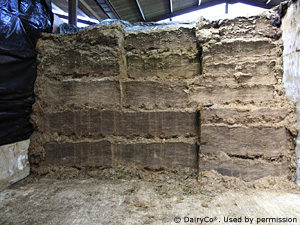Silage Potential Acid Load (PAL)
1 October 2015 Among the many useful pieces of information contained in the silage analysis report is the item PAL. This is the potential acid load in the animals rumen that the silage will incur when it is fed. It is made up of two parts:
Among the many useful pieces of information contained in the silage analysis report is the item PAL. This is the potential acid load in the animals rumen that the silage will incur when it is fed. It is made up of two parts:
- The acid content of the silage, which tends to be higher for low dry matter content silages. This is because the silage bacteria will have to ferment more sugars to acid in order to reduce the pH sufficiently to stabilise the fermentation.
- The amount of acid that will be produced by the microbes when it is fermented in the rumen, which tends to be higher for higher digestibility (D value) silages.
So, a wet silage with a high D value will usually have a high PAL (above 900).
Usually a silage with a high PAL fed alone will not be a problem but with silage above 1,100 seek nutritional advice. This is why PAL values over 900 are now print in red – as a warning. However, if it is fed with significant amounts of cereals (starch) then the resulting rumen fermentation could produce a large amount of acid and lead to acidosis. If this is the case the cereal allowance should be split into more meals per day or the cereals could be mixed with the silage to make a total mixed ration (TMR). Alternatively some of the cereals could be replaced with a source of digestible fibre, such as sugar beet pulp or soya hulls. In all cases the extent of processing of cereals should be minimal – just enough to crack open the grain. If problems still occur then it may be worthwhile feeding a rumen buffer or yeast product.
Colin Morgan
Sign up to the FAS newsletter
Receive updates on news, events and publications from Scotland’s Farm Advisory Service
